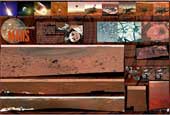
 |
|
|
This book intends to make use of the geological and topographical discoveries by recent space probes in order to better inform the lunar observer. Chapter One is a general introduction to the Moon. I thought that the section on the Moon’s orbit was rather over-simplified and needed beefing up a little, and a diagram would have helped in the part about libration. In discussing water on the Moon, no mention is made that water may be produced in the lunar soil by the action of the solar wind on lunar minerals, when hydrogen ions combine chemically with oxygen atoms in silicates and oxides. The second chapter is a straightforward summary of robot probes and the Apollo missions. Oddly, no images from any of these probes make it into this chapter; incredibly, only three images from space probes feature in the entire book! Photographs of lunar features are mainly black and white close-ups taken from The Consolidated Lunar Atlas (1967); sadly, no high-resolution CCD views by modern astro-imagers are present, nor are there any lunar observational drawings. Lunar geology and the history of the Moon is the subject of the third chapter, dealt with in a pretty concise and understandable manner. Occultations and eclipses feature in the following chapter, although there are some errors, such as the erroneous claim that refraction effects on the rising Moon cause it to look larger than when it is higher in the sky. Chapter five deals with observing the Moon, and contains a five-stage guide to the Moon’s main features followed by a brief guide to lunar photography. Studying the Moon is the subject of the book’s final chapter. In it the author selects 17 ‘study areas’ around the Moon’s nearside and describes the main features in each area with the aid of a labelled photograph. It’s a workmanlike chapter, but I feel that it’s somewhat lacking in instilling inspiration to readers to go out and observe. On the whole, Wilkinson has done a reasonable job of describing lunar phenomena and features. I was not greatly enamoured with his writing style, which I found tended to be clumsy in places. Moreover, the book is visually less than appealing – I think this matters because lunar imaging and observation relies on the sense of sight. Peter Grego
|
|
|
|
2009 Yearbook This 132-page special edition features the ultimate observing guide for 2009, a review of all the biggest news stories of 2008, in depth articles covering all aspects of astronomy and space missions for 2009, previews of International Year of Astronomy events and much, much more. This 132-page special edition features the ultimate observing guide for 2009, a review of all the biggest news stories of 2008, in depth articles covering all aspects of astronomy and space missions for 2009, previews of International Year of Astronomy events and much, much more.Infinity Rising  This special publication features the photography of British astro-imager Nik Szymanek and covers a range of photographic methods from basic to advanced. Beautiful pictures of the night sky can be obtained with a simple camera and tripod before tackling more difficult projects, such as guided astrophotography through the telescope and CCD imaging. This special publication features the photography of British astro-imager Nik Szymanek and covers a range of photographic methods from basic to advanced. Beautiful pictures of the night sky can be obtained with a simple camera and tripod before tackling more difficult projects, such as guided astrophotography through the telescope and CCD imaging.Exploring Mars  Astronomy Now is pleased to announce the publication of Exploring Mars. The very best images of Mars taken by orbiting spacecraft and NASA's Spirit and Opportunity rovers fill up the 98 glossy pages of this special edition! Astronomy Now is pleased to announce the publication of Exploring Mars. The very best images of Mars taken by orbiting spacecraft and NASA's Spirit and Opportunity rovers fill up the 98 glossy pages of this special edition!Mars rover poster  This new poster features some of the best pictures from NASA's amazing Mars Exploration Rovers Spirit and Opportunity. This new poster features some of the best pictures from NASA's amazing Mars Exploration Rovers Spirit and Opportunity. |
||||||||||||||||||||||||